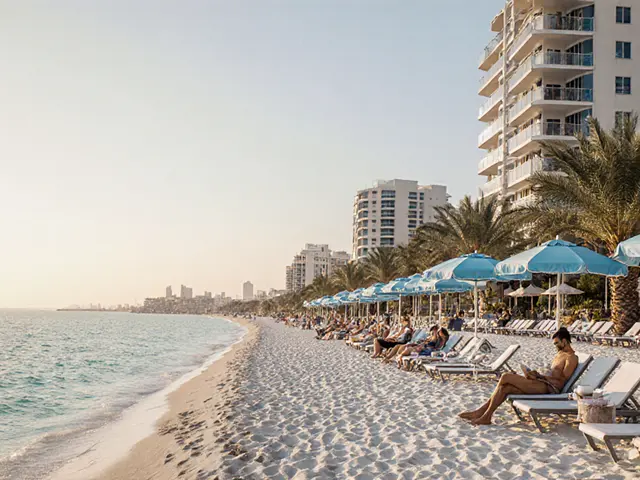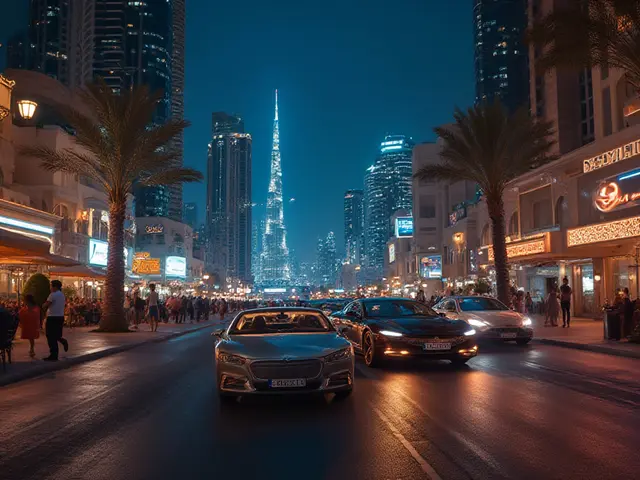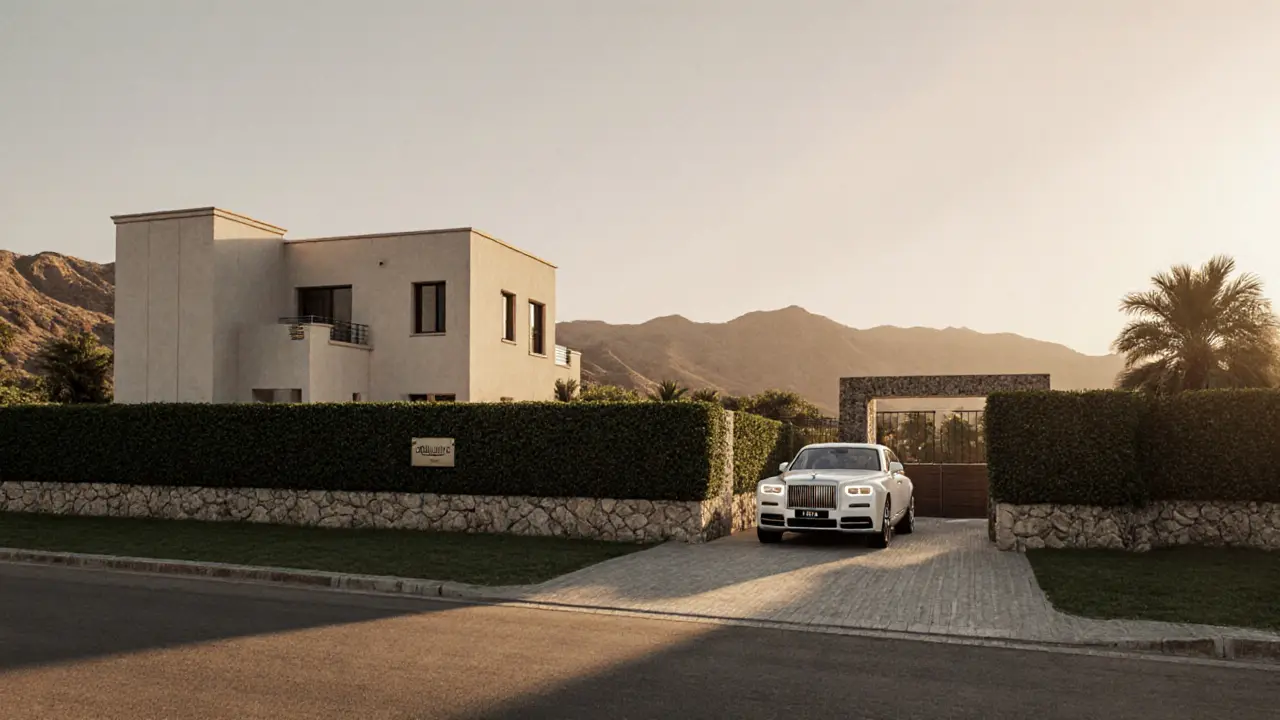
If you’ve ever wondered where Dubai’s wealthiest residents actually live, it’s not just about penthouses with views of the Burj Khalifa. The city’s richest don’t just cluster in one spot-they spread across a handful of exclusive enclaves, each with its own vibe, rules, and price tags. Forget what you see in movies. Real wealth here isn’t flashy-it’s quiet, private, and carefully curated.
Emirates Hills: The Crown Jewel of Dubai’s Elite
Emirates Hills is where Dubai’s billionaires send their private jets and keep their yachts out of sight. This gated community sits just south of the Dubai Hills Estate, surrounded by rolling desert hills and manicured fairways. Homes here start at $5 million and often climb past $30 million. The average villa is over 15,000 square feet, with private pools, home theaters, and staff quarters. You won’t find billboards or neon signs. Instead, you’ll see low walls, high hedges, and security gates that don’t blink when a Rolls-Royce rolls through.
It’s not just about space-it’s about control. Residents here own entire blocks. Some have their own mosques, tennis academies, and even private helipads. The community is so exclusive that even other wealthy Dubai residents rarely get invited in. It’s the kind of place where a neighbor might be a Saudi prince, a Russian oligarch, or the founder of a tech unicorn you’ve never heard of.
Palmera Beach: The New Money Meets Old Money
Just north of Palm Jumeirah, Palmera Beach has quietly become the preferred address for tech founders, private equity partners, and Middle Eastern royalty who want privacy without the old-school formality of Emirates Hills. This development, completed in 2023, offers beachfront villas with direct access to a private 2-kilometer stretch of sand. Unlike the crowded beaches of Palm Jumeirah, here you’ll find no tourists, no beach clubs, just quiet sunrises and a handful of neighbors.
What makes Palmera Beach different? It’s designed for people who hate crowds. Each plot is at least 1,500 square meters. The architecture is modern minimalism-clean lines, natural stone, floor-to-ceiling glass. No domes, no gold trim. The community has a single restaurant, open only to residents and their guests. Security is handled by a private firm that doesn’t use cameras on public roads. You’re not just buying a house-you’re buying silence.
Dubai Hills Estate: The Family-Friendly Power Center
If you’re a wealthy family with kids, Dubai Hills Estate is where you settle. It’s not just about luxury-it’s about lifestyle. The neighborhood has its own golf course, a 200,000-square-foot shopping mall, multiple international schools, and a 12-hectare park with walking trails and lakes. Homes here range from $2.5 million to $15 million, making it more accessible than Emirates Hills but still out of reach for 99% of the population.
What’s surprising is how normal it feels. You’ll see parents dropping kids off at GEMS Wellington Academy, families picnicking by the lake, and local chefs running organic food delivery services. The rich here aren’t hiding-they’re just living. And they’ve built a self-sufficient ecosystem where you can live, work, and raise kids without ever needing to leave the neighborhood.
Al Barsha South: The Quiet Alternative
Don’t assume all the rich live on the coast. Al Barsha South, tucked between the Dubai Metro and the Dubai Festival City mall, is home to a surprising number of ultra-wealthy families who work in finance or logistics. These aren’t villas-they’re sprawling townhouses with private gardens, rooftop terraces, and underground garages for five cars. Prices start at $1.8 million, but the real draw is convenience.
Residents here value time more than views. They’re close to Dubai International Airport, the Dubai Mall, and the city’s top private hospitals. Many own multiple properties but choose Al Barsha South as their primary home because it’s efficient. No traffic jams on the way to school. No long drives to the clinic. And the security is tight-private guards, biometric access, and no public signage.
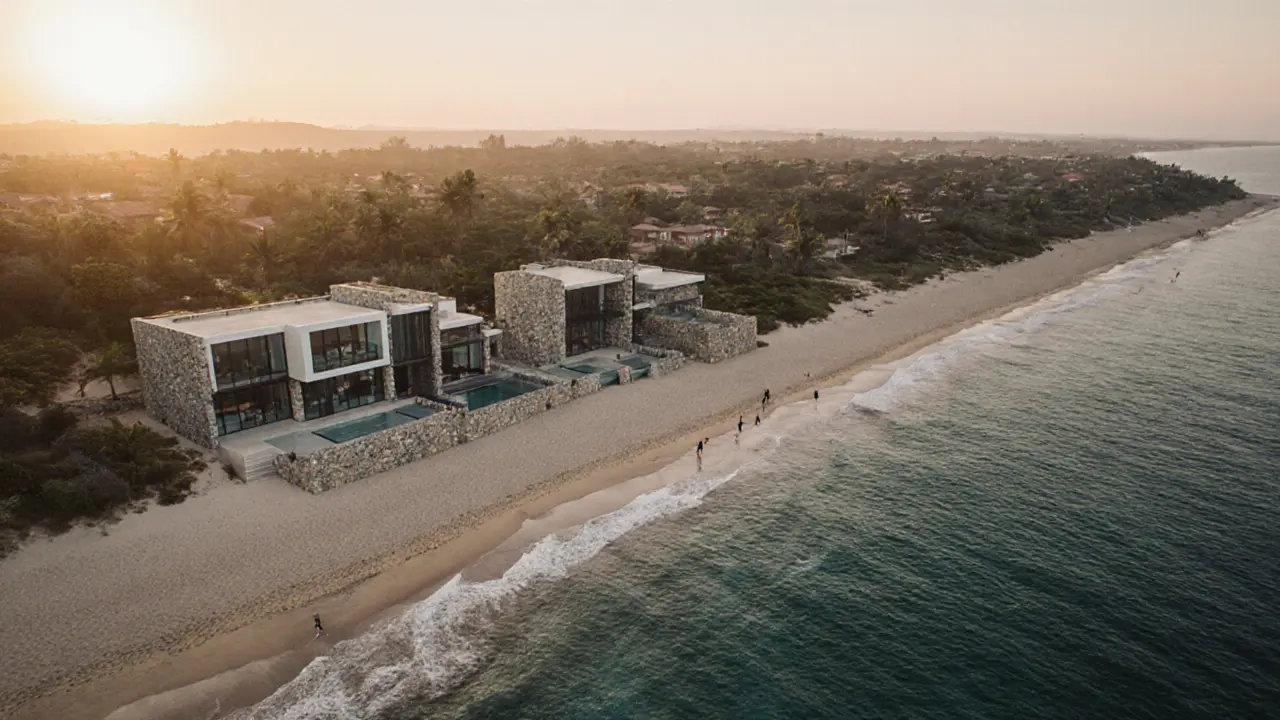
Palm Jumeirah: The Icon, But Not the Default
Palm Jumeirah is what tourists think of when they imagine Dubai’s rich. And yes, some of the wealthiest live here-especially in the Frond A and Frond B sections. But the truth? Many of the ultra-rich moved out after 2020. Why? Crowds. Tourists. Instagrammers. The beach clubs got too loud. The restaurants too expensive for anything but show.
Now, the real wealth on the Palm lives in the villas with no names on the gates, the ones you can’t see from the monorail. These are homes with 360-degree ocean views, private elevators, and indoor pools that double as spas. But even here, the trend is shifting. More owners are renting out their units to long-term tenants than living in them. The ones who do stay? They rarely appear on social media.
Al Sufouh: The Secretive Power Base
Just south of the Dubai Marina, Al Sufouh is where the old money of Dubai lives-families who’ve been here since the 1980s, oil traders, and government-connected investors. The homes here aren’t the biggest, but they’re the most secure. Many are walled compounds with multiple layers of fencing, guardhouses, and underground bunkers.
Unlike Emirates Hills, Al Sufouh doesn’t market itself. There are no brochures. No real estate agents with glossy flyers. You hear about it through word of mouth. The residents don’t want attention. They don’t need it. Their wealth isn’t tied to a startup or a crypto fortune-it’s tied to land, legacy, and influence. If you see a black SUV with tinted windows parked outside a villa here, it’s probably not a tourist.
What They Don’t Tell You About Living Here
Living in these neighborhoods isn’t just about money. It’s about access. The rich in Dubai don’t just own homes-they own privileges. Private medical clinics that don’t require appointments. Schools with waiting lists that stretch for years. Concierge services that arrange for a chef to fly in from Paris for dinner. And yes, there’s a hidden cost: isolation.
Many of these neighborhoods are so exclusive that residents rarely interact with anyone outside their circle. Social events happen behind closed doors. You won’t find them at public events or charity galas. They donate anonymously. They send their kids to international schools where no one asks about net worth. The wealth here isn’t displayed-it’s protected.
And then there’s the legal side. Foreigners can own property in these areas, but only under strict freehold rules. You can’t buy land outright in Al Sufouh. You can’t build a new villa in Emirates Hills without approval from the community board. Even the color of your fence might need permission. This isn’t just real estate-it’s a membership.
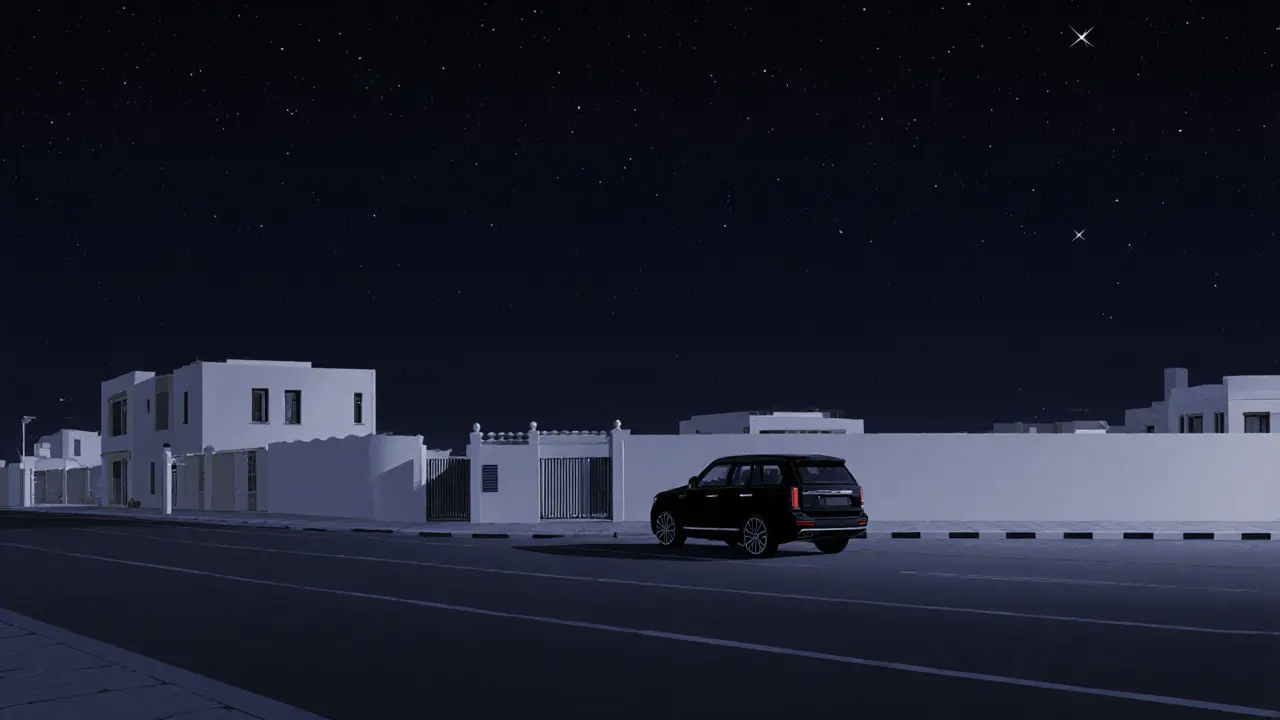
Who Actually Lives There?
It’s easy to assume all the rich in Dubai are Arab royalty or Russian oligarchs. But the truth is more complex. According to a 2024 report by Knight Frank, 42% of ultra-high-net-worth individuals in Dubai are from South Asia-mostly Indian and Pakistani entrepreneurs who built businesses in logistics, tech, and real estate. Another 28% are Europeans-mostly British, German, and French executives working for multinational firms. Only 12% are from Gulf countries.
There are also American tech founders, Chinese investors, and African mining magnates. What they all have in common? They don’t want to be seen. They want stability. Security. And a place where their kids can grow up without being stared at.
How to Know If You’re Looking at the Right Place
If you’re trying to spot where the real wealth lives, don’t look for the biggest buildings. Look for the quietest streets. Look for homes with no signs, no gates that open for strangers, and no visible security cameras. Look for properties with multiple garages but no visible cars. Look for neighborhoods where the only sound is birds and distant waves.
And if you’re thinking of moving here? Forget the brochures. Talk to residents. Ask about schools. Ask about security. Ask if you can get a private doctor without a six-month wait. If the answer is yes, you’re getting close.
Final Thought: Wealth Here Is Invisible
Dubai’s rich don’t live to impress. They live to be left alone. Their homes aren’t Instagram backdrops-they’re sanctuaries. The most valuable thing in these neighborhoods isn’t the marble floors or the infinity pools. It’s the silence. The privacy. The peace.
If you want to understand where the rich live in Dubai, don’t look at the skyline. Look at the empty roads. Listen for the absence of noise. That’s where the real wealth hides.
Are these neighborhoods open to foreigners?
Yes, foreigners can buy property in all of these areas under Dubai’s freehold ownership rules. However, some communities like Al Sufouh and Emirates Hills have strict approval processes. You’ll need to pass background checks, prove financial stability, and sometimes get a recommendation from an existing resident. It’s not automatic-it’s selective.
What’s the minimum budget to live in one of these areas?
You need at least $1.8 million to buy a townhouse in Al Barsha South. For a villa in Dubai Hills Estate, expect $2.5 million. In Emirates Hills or Palmera Beach, prices start at $5 million and can go well beyond $30 million. Renting a luxury villa in these areas costs $120,000 to $400,000 per year, depending on size and location.
Do the rich in Dubai pay taxes?
No, Dubai has no personal income tax, capital gains tax, or property tax. That’s one reason why so many wealthy people choose to live here. The only costs are the purchase price, annual service fees (which can range from $5,000 to $20,000 depending on the community), and utility bills. There’s no inheritance tax either, making it a popular base for global wealth planning.
Are these areas safe?
Extremely. These neighborhoods have private security forces, biometric access, 24/7 patrols, and no public access roads. Crime rates are virtually zero. In Emirates Hills, for example, the community employs former military personnel and ex-intelligence officers. Most residents don’t lock their doors-not because they’re careless, but because they don’t need to.
Can I visit these neighborhoods as a tourist?
You can drive through some areas like Dubai Hills Estate or parts of Palm Jumeirah, but you won’t be allowed to enter gated communities like Emirates Hills or Al Sufouh. Security checkpoints block unauthorized vehicles. Even walking into a private beach area in Palmera Beach will get you turned away. These aren’t tourist attractions-they’re private residences.


